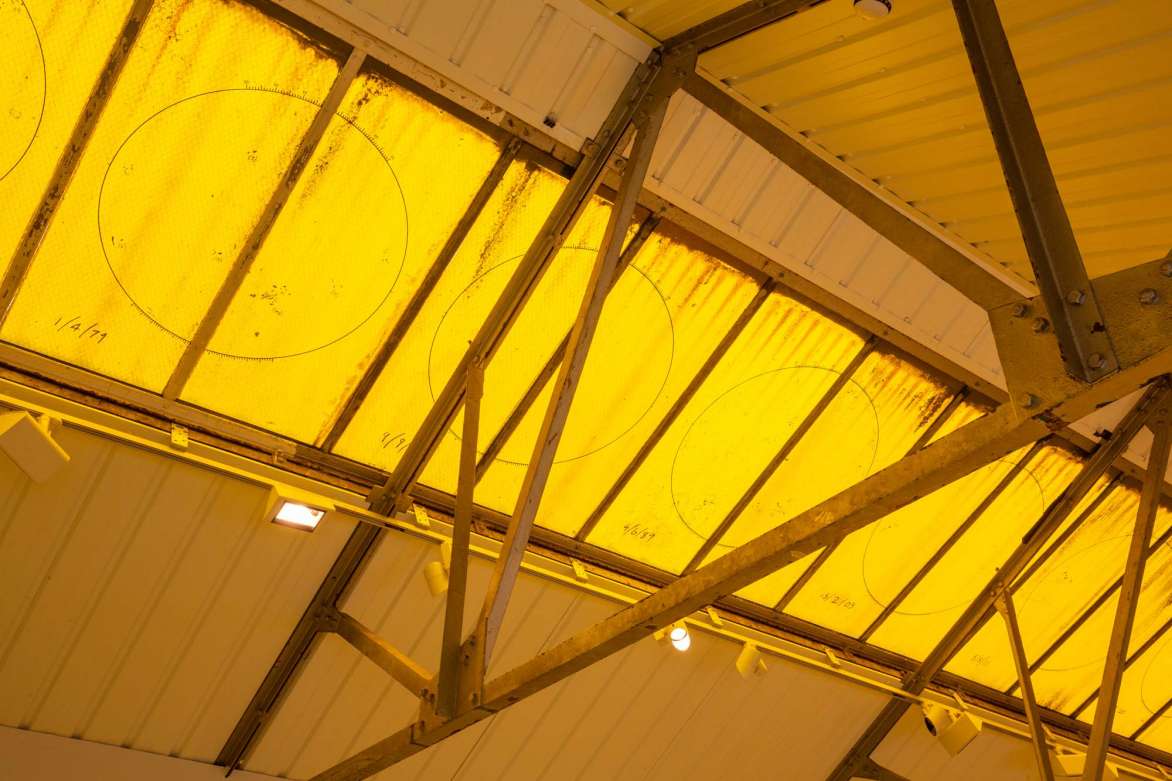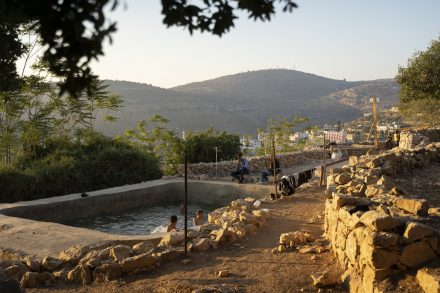ACT Professor Nida Sinnokrot’s course, Common Ground, examines artistic practice as a form of critical inquiry and knowledge production. The class offers students the opportunity to develop projects as a means for addressing the social, cultural, and ecological consequences of technology. Additionally, it builds bridges between industry and culture and challenges the boundaries between public and private and human and non-human.
A focal point of this transdisciplinary course is learning from the land, specifically at the site in Palestine known as Sakiya. One of Sinnokrot’s projects, Sakiya is a progressive academy for experimental knowledge production and sharing, grafting local agrarian traditions of self-sufficiency with contemporary art and ecological practices. Gary Zhexi Zhang (SMACT ‘19), the teaching and research assistant for the course, described Sakiya as “a ‘nomadic university’ – a kind of pedagogical institution that involves art, science, and agriculture, and is connected to ideas around permaculture, ecology, and the conservation of nature and culture.”
Sinnokrot, along with Sahar Qawasmi, an architect and conservationist, founded Sakiya in 2016 as a nomadic organization. In 2017 they were entrusted with a natural and historic site in Ein Qiniya west of Ramallah owned by the Zalatimo family from Jerusalem. In 2018 they received a grant from the A M Qattan Foundation through the Visual Arts: A Flourishing Field Project to renovate and establish Sakiya on this uniquely re-wilded site. Sakiya’s core programs include food production, exhibitions, symposia, publications, and education/training workshops, exploring the intersections between art, science, and agriculture in a sustainable and replicable model.
The class comes out of a new pedagogical initiative, supported by the Abdul Latif Jameel World Education Lab (J-WEL), to address growing ecological crises, displacement from land, and alienation from heritage by engineering solutions that bring together art, science, and agriculture for interdisciplinary study.
In the current context of climate catastrophe, and ecological concern, the idea of the class is learning from locations that have a deeply rooted, land based knowledge. “The history of art is linked to the history of agriculture, intrinsically linking culture and land,” Zhang said. “Sakiya’s site exists at the heart of the fertile crescent, near the first human forays into agriculture.”
During the March spring break, students in the class joined Sinnokrot and Zhang on a site visit to Sakiya to learn and create, first hand. “Using methodology from art, design, and technology, we wanted to see what we could learn from ancient, so-called ‘primitive,’ technologies,” Zhang explained. “The idea was how and what can we learn from these very traditional, low tech forms, where people have learned to grow and to flourish in extreme or non-ideal conditions. How did they deal with droughts, irrigation, cooperative labor practices?”
“We spent 5 days at Sakiya, where the students really just explored and got to know the site, learned about the ecology, explored, and cooked together. It was a site visit and there was surveying and analytical work going on, but the majority of the trip itself was really just becoming, in the short amount of time, very intimate with the environment. We visited the Palestinian Museum in Birzeit and met with different researchers. We also visited Palestinian tile makers, glass blowers, and farmers who were using traditional methods. Students were able to get pretty deeply involved with the artists and community in Ramallah even in this short time.”
The class began by looking at some key architectural typologies from the area. One of these is the mintar, the traditional Palestinian drystack stone dome shelter, which is quite common across the Mediterranean. Architecturally, the mintar and drystack walls can be looked at for their thermal properties – the way it is built, it can cool – yet it can also be looked at from a cultural and political point of view.” He also said that students in the course experimented with building a mintar in MIT Building N10.
The practical aspect of the class is taking these ideas and developing new projects, in the context of Sakiya, after having visited. The main group projects for the midterm were focused around 3 typologies: re-imagining the efficient, hot burning, and portable rocket stove as architecture; the earth closet as a metabolic clock; and the zeer pot, an evaporative cooling system for storing vegetables, as a shelter and water purification system.
One design for an earth closet emerged from a collaborative project with MIT and Harvard students. This mechanical version of the earth closet is currently being built upon a hilltop at Sakiya. The structure itself is a covered toilet, yet you could see across the entire vista. It also became “a kind of toilet clock” Zhang said. “You have to rotate it to avoid the ‘peaking problem’ where all of the waste winds up piled in the center.” The students were able to apply design skills to very practical, and very contextually situated designs, given the aspects of the site. Individual artistic projects ranged from exploring the Canaanite spirit mythologies associated with the site to photogrammetry, seed bombing and mapping projects as well as exploring ways to re-enchant agri-cultural practices.
The initiative will continue through this summer with a symposium at Sakiya; there will be an exhibition which will showcase some of the student projects. As part of Sakiya’s nomadic, pedagogical ideas, contributions from the students’ research through the class, research presented at the symposium, and the work of collaborators, will be compiled into a publication. “The idea is for it to be a kind of handbook,” Zhang said, “a curriculum going forward as part of Sakiya’s pedagogical mission.”







